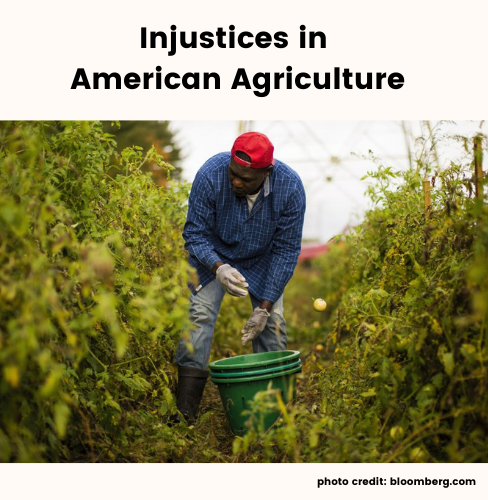As we uncover some of the realities of American Agriculture in 2021, it is crucial to reflect back on the beginnings. We could consider this to date back to the inception of America, or perhaps the modernization and industrialization of agriculture in the early 1900’s. For the purposes of our articulation, we will mark the scope to start at 1863, when the Emancipation Proclamation was issued - though we include that the news of emancipation didn’t reach Galveston, Texas, until over two years later on June 19th, 1865.
As we turn to look at systemic issues in our long withstanding food production and consumption structures, it is important to note that the modern industrial agriculture that we see today thrives, largely in part by systemic racism and oppression that targets BIPOC. Between sharecropping and unfair practices perpetuated by landowners as soon as the Emancipation Proclamation took full effect, the system was set to unfairly target formerly enslaved people and prohibit them from building a strong economic foundation. Sharecropping in and of itself is a practice that encourages tenants to work incredibly hard and for long days - it often ensured that the farmers would remain tied to the land and it was rare that one could break out of the sharecropping cycle to set out for new opportunities.

Image Source: Library of Congress
According to Racial Injustice: The Truth About Industrial Agriculture, “In 1910, 14% of all farmer owner-operators were Black or African American [...]” and in 2021, that percentage went down to 1.5%. This was due largely in part to discrimination perpetrated by the USDA (United States Department of Agriculture) and the FSA (Farm Service Agency, formerly the Farmers’ Home Administration) - these practices of denying loans to qualifying Black or African American was pivotal in the dramatic loss of land - roughly 820 acres a day during 1950 and 1969 alone. Between the introduction of synthetic fertilizers and pesticides alongside the industrialization of the industry, farming practices on a large scale became inhumane - not sustainable for neither the planet nor the people.

Circling back to Reconstruction, we highlight what W.E.B. Du Bois called “land hunger” - while some found sympathetic white landowners who would sell to them, some squatted on unused land - two generations of black workers squirreled away money and went after every available and affordable plot they could, no matter how marginal or hopeless. The separation in land ownership can be dated back to the era of Reconstruction in America as it predisposed many of those who were once enslaved to living and working conditions that were unfortunate and unsustainable.
The community of farmers across America continued to grow and, as white males continued to secure stable farming jobs, BIPOC and migrants made up a lot of the modern workforce, though these jobs were less desirable and and the owners of these industrial farms were able to avoid accountability for less-than working conditions that were often times incredibly unsafe. The migrant and BIPOC populations saw an increase in illness and disease as a result of these horrific and unregulated working conditions.
Part of the issue at hand is that nearly one-third of the workers in this industry are immigrants and, according to Human Rights Watch, “violations of immigrant workers’ rights is a national problem requiring a national policy response”(HRW.org). By attempting to maximize production and minimize cost, labor and the quality of life at work suffered. It is no secret that employers that typically hire immigrants will not have to follow the same standards of the workplace as a result of systemic inequities and discrimination.
In the 1960’s and 70’s, America saw an introduction to industrialized meat farming practices as CAFO (Confined Animal Feeding Operation) came into play - these upgraded models that sped up farming processes were rather expensive and, as with the loss of land due to the denial of loans, white farmers were disproportionately approved for loans to upgrade their farming machinery more often than Black or African American farmers. Today, we see that white males make up about 96% of the chicken farming industry, according to USDA census data.
Various human rights organizations have delved into the world of American agriculture during COVID-19; with inspecting the level of workers rights granted and have come up with shocking evidence that calls for an end to the industry. Organizations such as Food Is Power, and the Center for Disease Control have shed light on the workers rights violations present in most slaughterhouses across the United States that make it possible for disease to thrive; these include but are not limited to lack of proper breaks, overtime pay, sanitary and safe conditions, as well as proper pay and oversight of business.
In The Great Land Robbery: The shameful story of how 1 million black families have been ripped from their farms by Vann R. Newkirk II, as the title suggests, the publication both articulates and showcases the changing of agricultural conditions throughout the Mississippi Delta, originating during the era of Reconstruction. Newkirk II showcases the importance of landowning in the farming industry and the horrifying means by which land was held from black agricultural workers - a war waged by deed of title has dispossessed 90 percent of black agricultural landowners in America. This displacement has carried on and solidified systemic issues in landowning and farming that have not yet been broken.
Using a human rights perspective, we see the more obvious violations of workers rights such as lack of healthy and safe working conditions. There is an incredible lack in regulation and oversight and a turning of heads. In a more recent report done by Human Rights Watch, “When We’re Dead and Buried, Our Bones Will Keep Hurting” Workers’ Rights Under Threat in US Meat and Poultry Plants, the ways in which workers’ rights abuses rise as more autonomy is granted to animal agriculture industries as time goes on. Human rights norms enforce that workers are in safe conditions free from unlawful hazards. Workers interviewed from various plants across the United States reported serious injuries or illnesses caused by work - scars, missing fingers, stress, and psychological strain. Many reported that most of their life now has to revolve around “managing chronic pain or sickness”(HRW.org).
It is in these practices that harm animals and the environment that we see these staggering statistics showcasing disproportionate opportunities between white and African American or Black farmers.
Human Rights Watch has kept their eye on human rights violations apparent in meat and poultry “processing facilities” for nearly two decades now. In 2005, they released their full report, Blood, Sweat and Fear: Workers' Rights in U.S. Meat and Poultry Plants, which highlighted the detrimental effects of this business on humans. This report calls for government obligations, corporate responsibility, and for the United States to utilize the human rights instruments already in place to protect these workers. The report outlines specific failings in the infrastructure of the business, including but not limited to: line speed, close quarters cutting, long hours, and inadequate training and equipment. The very failures of the workers’ rights systems within the United States infrastructure is highlighted through observation of the meat and poultry industry.
Human Rights Watch is the human rights institution that is covering this issue the most, alongside projects such as The Food Empowerment Project, They're Trying To Kill Us, and the Southern Poverty Law Center. This issue is covered by and large within the animal and environmental rights movements, though is not at the forefront of many human rights projects.
As the American public learns more and more about the abuses of slaughterhouse workers as well as the detrimental effects of consuming animal products on our health and the environment, meat sales continue to see significant drops. COVID-19 has brought about astronomical rises in plant-based purchases and a decline in the meat and dairy industry. Unfortunately, the government chooses to intervene by providing government subsidies and bailing out these harmful industries. In the United Kingdom, there are initiatives to promote the closing of these dangerous meat and poultry plants and a shifting of the labor towards plant-based agriculture; these shifts in labor are a success as it has kept their COVID-19 cases, injuries, and health risks standard. There is a way out and a brighter future ahead.
If things continue as they are, we are looking at detrimental effects on BIPOC communities, the environment, the response to COVID-19, and the protections of workers’ rights as we know it. This is a petrifying example of how workers’ rights can be abandoned; more industries will continue to falter if they follow in the footsteps of slaughterhouses. These employees are exploited, overworked, and under-protected. This injustice may be an inevitable part of the industry - intersectionality reigns true as one sector of rights affects the other inevitably. Considering intersectionality and the inherent interconnectedness of our ecosystems - is there hope for human rights in a world where animals and the environment are exploited for profit? The murderous conditions in a slaughterhouse necessitate an abandonment of principle and morale, making it far too easy for human rights to be abandoned alongside animal. Until changes are made accordingly, the raging fire of COVID-19 through the lives of slaughterhouse workers will continue on.
“The meat industry relies on people not being able to see how it operates [...] The more we know about how meat gets made, the harder it is to love [...] It’s responsible for serious crimes against people too [...] Cattle ranches and meatpacking facilities worldwide are known as hotspots for modern slavery”(Greenpeace).
----
About Terra Thread:
Terra Thread organic backpacks and bags are created for conscious consumers, corporations, and NGOs who are looking to make a positive impact on the world with their purchases. Terra Thread puts people and the planet first, every step of the way from organic farms to your arms.
In this age of fast fashion, Terra Thread is taking a stand against the exploitation of industry workers. To protect our workers, we ensure that they have safe working environments, gender equality, and are paid a fair price for their goods and services. To uphold these standards, our products are made from Fairtrade Organic Cotton in a Fair Trade Certified Factory.
Terra Thread and its parent company, Gallant are working with 411 farmers, covering 1100 acres of organic cotton farmland, to certify ROC (Regenerative Organic Certified) cotton for this season of 2021 - more to come.





